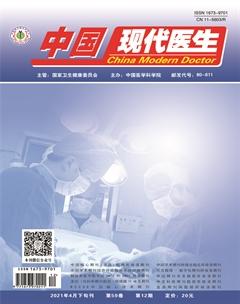試管嬰兒雙胎妊娠的母嬰臨床結局研究
屠世炯 何小波
[摘要] 目的 探討試管嬰兒雙胎與單胎妊娠的母嬰臨床特征及妊娠結局。 方法 回顧性分析2017年1月至2019年12月在我院產科住院分娩的試管嬰兒病例620例,其中雙胎妊娠195例作為研究組,單胎妊娠病例425例作為對照組,對其分娩前及分娩后臨床資料及數據等進行研究分析。 結果 研究組的住院天數(12.77±2.96)d、妊娠高血壓疾病(19.00%)、早產(60.00%)、低出生體重兒(28.20%)均高于對照組的(9.92±1.26)d、11.30%、15.80%、5.60%,差異均有統計學意義(P<0.05)。研究組剖宮產分娩率(99.00%),產后出血例數(25.60%),宮腔球囊填塞止血例數(29.20%)均高于對照組的66.60%,17.60%,12.00%,差異均有統計學意義(P<0.05)。但研究組的高齡妊娠例數(20.50%)和胎膜早破例數(12.30%)均低于對照組的29.90%、16.90%,差異均有統計學意義(P<0.05)。 結論 試管妊娠雙胎與單胎相比,其母嬰并發癥及合并癥明顯多于單胎,故對于不孕不育的患者在移植過程中,對于胚胎移植數目需嚴格按照指南進行,加強產前檢查, 監測孕期胎兒體重情況, 積極處理,避免不良結局的發生。
[關鍵詞] 試管妊娠;雙胎妊娠;圍產結局;并發癥
[中圖分類號] R714.2? ? ? ? ? [文獻標識碼] B? ? ? ? ? [文章編號] 1673-9701(2021)12-0079-04
Study on the mother and infant clinical outcome of twin pregnancy in test-tube baby
TU Shijiong? ?HE Xiaobo
Department of Obstetrics, Ningbo Women and Children′s Hospital, Ningbo? ?315012, China
[Abstract] Objective To explore the mother and infant clinical characteristics and pregnancy outcome of test-tube twin pregnancy and singleton pregnancy. Methods A total of 620 cases of test-tube babies who were hospitalized and gave birth in the Department of Obstetrics in our hospital from January 2017 to December 2019 were retrospectively analyzed. Among them, 195 cases of twin pregnancy were used as the study group, and 425 cases of singleton pregnancy were used as the control group. The clinical data before and after delivery were studied and analyzed. Results The length of stays(12.77±2.96)days,the number of cases of pregnancy-induced hypertension (19.00%), the number of preterm births (60.00%),and the number of low birth weight infants(28.20%) in the study group were all higher than the length of stays(9.92±1.26)days, the number of cases of pregnancy-induced hypertension(11.30%), the number of premature births(15.80%), and the number of low birth weight infants(5.60%) in the control group, and the differences between the two groups were statistically significant(P<0.05). The delivery rate of Cesarean section (99.00%), the number of cases of postpartum hemorrhage (25.60%), the number of cases of uterine balloon tamponade hemostasis (29.20%) in the study group were higher than the delivery rate of Cesarean section(66.60%), and the number of cases of postpartum hemorrhage(17.60%), the number of cases of uterine balloon tamponade hemostasis(12.00%) in the control group, and the differences between the two groups were statistically significant(P<0.05). However,the number of cases of elderly pregnan group(20.50%) and premature rupture of membranes(12.30%) in the study group were lower than those in the control group (29.90% and 16.90%), and the differences between the two groups was statistically significant(P<0.05). Conclusion Compared with singleton pregnancy, test-tube twins have significantly more mother and infant complications and concurrent disorders than singleton pregnancy. Therefore, in the process of transplantation for infertile patients, the number of embryo transfers must be carried out in strict accordance with the guidelines, prenatal inspections should be strengthened, and the fetal weight during pregnancy should be monitored. Measures should be carried out in a timely manner to avoid adverse outcomes.
[Key words] Test tube pregnancy; Twin pregnancy; Perinatal outcomes; Complications
隨著環境的變化及自身因素改變,近年來,不孕不育發病率明顯上升,在發達國家不孕不育的發生率為5%~8%[1],我國不孕不育發病率為15%[2],遠高于歐美國家,故借助生殖輔助技術的需求明顯增加。自1978年第1例試管嬰兒誕生,距今已40余年,體外受精胚胎移植術(In vitro fertilization-embryo transfer,IVF-ET)簡稱試管嬰兒技術[3],是治療不孕癥的有效手段之一,已廣泛運用于全世界,解決了大部分不孕不育癥;在發達國家,通過ART出生的試管嬰兒已占總數的1%~4%[1,4]。但此技術最常見的并發癥——多胎妊娠[5],越來越引起人們的關注。大量文獻已報道試管嬰兒雙胎妊娠與自然受孕雙胎妊娠的母嬰妊娠結局[4-6],其并發癥及合并癥明顯多于自然受孕雙胎,但國內外報道結局不一,且缺乏與單胎試管嬰兒妊娠結局的比較。故本研究對我院2017年1月至2019年12月試管嬰兒雙胎及單胎妊娠的母嬰情況進行比較分析,現報道如下。
1 資料與方法
1.1 一般資料
收集2017年1月至2019年12月在本院產檢并分娩的孕婦13 900例,其中試管嬰兒620例,以雙胎妊娠195例作為研究組,單胎妊娠病例425例作為對照組。納入標準:妊娠孕婦均行IVF-ET受孕及孕周≥28周。排除標準:受孕期合并有內外科疾病,如:高血壓、糖尿病等慢性疾病者;孕期行減胎術;雙胎一胎胎死宮內者。所有患者均自愿參加本研究并簽署知情同意書。
1.2 方法
①文中所提及的妊娠合并癥及并發癥(前置胎盤、糖尿病、胎膜早破、妊娠期高血壓疾病、產后出血)等各項基本的診斷均以謝幸等第9版《婦產科學》為標準[1]。②早產兒定義:妊娠達到28周但不足37周分娩者,此時娩出的新生兒稱為早產兒(Preterm neonates)[1];低出生體重兒定義:出生體重<2500 g的新生兒[1]。③國際婦產科聯盟將分娩年齡≥35歲的妊娠定義為高齡妊娠,此時期的孕產婦稱之為高齡孕產婦[4]。
1.3 觀察指標
本研究采用回顧性分析方法,對兩組孕婦一般資料(年齡、體質量指數、孕次、產次、住院天數)、分娩方式(剖宮產、陰道分娩)、妊娠期并發癥(前置胎盤、妊娠糖尿病、胎膜早破、妊娠高血壓疾病)、妊娠結局(產后出血)及新生兒情況(早產兒、低出生體重兒)發生情況進行比較。
1.4 統計學方法
采用SPSS18.0統計學軟件進行處理,計量資料以均數±標準差(x±s)表示,采用t檢驗,計數資料以[n(%)]表示,采用χ2檢驗,P<0.05為差異有統計學意義。
2 結果
2.1 雙胎剖宮產產后出血中患者兩組病例一般資料分析
195例雙胎和425例單胎妊娠的試管嬰兒的病例中,單因素分析結果顯示,兩組孕婦在一般資料,如年齡、體質量指數、初次妊娠均未見明顯差異,其合并有前置胎盤、妊娠糖尿病、絨毛膜羊膜炎等比較,差異無統計學意義(P>0.05)。但研究組住院天數、高齡妊娠、妊娠高血壓疾病、胎膜早破等指標明顯高于對照組,差異有統計學意義(P<0.05)。
2.2 兩組患者分娩中及分娩后情況分析
研究組剖宮產分娩率達到99.00%,單胎分娩剖宮產分娩率達到66.60%,產后出血發生例數及宮腔球囊填塞止血例數均多于對照組,研究組早產兒及低出生體重兒發生率均高于對照組,差異有統計學意義(P<0.05);其子宮切除及子宮動脈栓塞發生率與對照組比較,差異無統計學意義(P>0.05)。
3 討論
隨著不孕不育癥的發生率劇增和輔助生殖技術的進步,試管嬰兒在逐年增加。本研究中統計出近3年的試管嬰兒發生率為4.46%(620/13 900),遠遠高于歐美國家中通過ART出生的孩子(1%~4%)[7]。多胎妊娠是試管嬰兒技術最常見的并發癥,為了保證單次移植妊娠成功率,大部分移植中心常規移植2~3枚胚胎,同時使試管嬰兒多胎妊娠率達到15%~40%不等,遠遠高于自然妊娠的多胎率(1%~2%)[8-10]。本研究中,多胎妊娠率為31.5%(195/620),與報道相符。雙胎可引起母體宮腔壓力升高、營養需求增加,均增加早產及低出生體重發生風險,與本研究相符。故在中華醫學會生殖醫學分會中不孕癥指南(Single embryo transfer,SET)建議:對于預后情況良好的35~37歲女性,建議選擇性單胚胎移植,以降低多胎妊娠率和母嬰并發癥;對于預后情況不佳或>37歲的女性,可考慮雙胚胎移植,但需告知多胎妊娠和母嬰并發癥的風險[4,11]。
既往的研究發現雙胎妊娠不良妊娠風險的發生率明顯增多,且其合并癥及并發癥明顯高于單胎妊娠,尤其妊娠期高血壓疾病、糖尿病、早產的發生明顯高于自然妊娠雙胎及試管嬰兒的單胎,這和本文的研究相符[12-14],分析其原因可能為有不孕史的女性,即使未采用ART妊娠,不孕病史是產科并發癥和不良妊娠結局的獨立危險因素,女性隨著年齡增長,不僅生育能力下降,且不良妊娠結局的發生率也增加[16-17]。且在試管嬰兒妊娠過程中,促排卵治療及體外培養操作,均對胚胎的生長產生影響,同時體內超生理量的激素刺激,均會增加母體某些并發癥的發生風險[18]。
本研究提示我院試管嬰兒的雙胎妊娠剖宮產率為99.00%,其單胎妊娠的剖宮產率為66.60%,遠遠高于WHO警戒線。由于經過多年不孕治療,年齡偏大,認為胎兒來之不易,陰道試產危險性高,故多要求剖宮產分娩,同時由于社會因素和醫療環境的惡化,也導致醫源性剖宮產率的增加[19]。另發現試管嬰兒組雙胎妊娠產婦妊娠期高血壓疾病發生率較單胎妊娠產婦高[20],這和自然妊娠結局雙胎比單胎妊娠在妊娠期高血壓疾病方面多3~4倍[1,21],且存在發病早,程度重,容易出現心肺并發癥及子癇。本研究提示胎膜早破發生率試管嬰兒組雙胎和單胎妊娠,有明顯差異性,既往研究顯示,其發生率約達14%[1,21],可能與宮腔內壓力增高有關,同時產后出血發生率也明顯增加。
本研究對試管嬰兒雙胎及單胎的不同結局進行分析,發現試管妊娠雙胎與單胎相比,其母嬰并發癥及合并癥(妊娠高血壓疾病、產后出血、早產、低出生體重兒)明顯多于單胎,故對于不孕不育的患者在移植過程中,對于胚胎移植數目需嚴格按照指南進行[4,15],同時加強產前檢查,監測孕期胎兒體重情況,積極處理,以減少宮內發育不均衡的發生。警惕妊娠期合并癥的發生,早期積極處理,避免不良結局的發生。
[參考文獻]
[1] 謝幸,孔北華.婦產科學[M].9版.北京:人民衛生出版社,2018:141-146.
[2] 陳子江,劉嘉茵,黃荷鳳,等.不孕癥診斷指南[J].中華婦產科雜志,2019,54(8):505-511.
[3] Chie Nagata,Limin Yang,Kiwako Yamamoto-Hanada,et al. Complications and adverse outcomes in pregnancy and childbirth among women who conceived by assisted reproductive technologies:A nationwide birth cohort study of Japan environment and children′s study[J].Japan Environment & Children′s Study Group,BMC Pregnancy and Childbirth,2019,19(1):77-89.
[4] 孫瑩璞,黃國寧,孫海翔,等.中國高齡不孕女性輔助生殖臨床實踐指南[J].中國偱證醫學雜志,2019,18(3):253-266.
[5] S D′Arpe,S Franceschetti,MG De Stefano,et al.The impact of chorionicity and type of conception on maternal-neonatal outcome in twin pregnancies[J]. Clinical and Experimental Obstetrics & Gynecology,2016,43(1):88-92.
[6] 楊悅.試管嬰兒雙胎妊娠與自然受孕雙胎妊娠臨床結果對比分析[J].泰山醫學院學報,2017,38(12):1417-1418.
[7] Jiabi B Qin,Hua Wang,Xiaoqi Sheng,et al. Assisted reproductive technology and risk of adverse obstetric outcomes in dichorionic twin pregnancies:A systematic review and meta-analysis[J].Fertility and Sterility,2016, 105(5):1180-1192.
[8] Ana Ballesta-Castillejos,Juan Gomez-Salgado,Julian Rodriguez-Almagro,et al. Obstetric and perinatal complications associated with assisted reproductive treatment in Spain[J]. Journal of Assisted Reproduction and Genetics,2019,36(12):2435-2445.
[9] G Bordi,AD′Ambrosio,I Gallotta,et al. The influence of ovulation induction and assisted conception on maternal and perinatal outcomes of twin pregnancies[J]. European Review for Medical and Pharmacological Sciences,2017,21(18):3998-4006.
[10] Sophie Deltombe-Bodart,Philippe Deruelle,Elodie Drumez,et al. Obstetrical and perinatal complications of twin pregnancies:Is there a link with the type of infertility treatment[J].Acta Obstetricia et Gynecologica Scandinavica,2017,96(7):844-885.
[11] Lei Lingling,Lan Yonglian,Wang Shuyu,et al. Perinatal complications and live-birth outcomes following assisted reproductive technology:A retrospective cohort study[J]. Chinese Medical Journal,2019,132(20):2408-2416.
[12] 蘇鈴雅.試管嬰兒早產兒與自然早產兒ROP發生率的比較[D].溫州:溫州醫科大學,2017.
[13] 武靜靜,張月蓮.自然受孕、試管嬰兒及促排卵受孕雙胎妊娠臨床結局研究[J].山西醫科大學學報,2019,50(4):493-496.
[14] DX Hua,F Liu,FY Diao,et al. Analysis on factors related to spontaneous reduction in twin pregnancy following assisted reproductive technology[J]. Zhonghua Yufang Yixue Za Zhi [Chinese Journal of Preventive Medicine],2018,52(10):1029-1033.
[15] Lu Luo,Xiongzhi Fan,Huiying Jie,et al.Is it worth reducing twins to singletons after IVF-ET? A retrospective cohort study using propensity score matching[J]. Acta Obstetricia et Gynecologica Scandinavica,2019,98(10):1274-1281.
[16] Ningyuan Zhang, Hua Chen, Zhipeng Xu, et al. Pregnancy,delivery, and neonatal outcomes of in vitro fertilization-embryo transfer in patient with previous cesarean scar[J]. Medical Science Monitor:International Medical Journal of Experimental and Clinical Research,2016,16(22):3288-3295.
[17] 趙彩巖.試管嬰兒雙胎及自然受孕雙胎的臨床結局分析[J].航空航天醫學雜志,2017,28(2):131-133.
[18] G David Adamson,Jacques de Mouzon,Georgina M Chambers,et al. International committee for monitoring assisted reproductive technology:World report on assisted reproductive technology,2011[J].Fertility and Sterility,2018,110(6):1067-1080.
[19] Barbara Luke. Pregnancy and birth outcomes in couples with infertility with and without assisted reproductive technology:With an emphasis on US population-based studies[J]. American Journal of Obstetrics and Gynecology,2017,217(3):270-281.
[20] Jennifer F Kawwass,Martina L Badell.Maternal and fetal risk associated with assisted reproductive technology[J]. Obstetrics and Gynecology,2018,132(3):763-772.
[21] Paola Algeri,Sara Ornaghi,Isadora VaglioTessitore,et al. Delivery and feto-neonatal outcomes of diamniotic twin pregnancies in women with no chronic disease or gestational complications:Impact of mode of conception[J].The Journal of Maternal-Fetal & Neonatal Medicine,2020, 33(12):2081-2088.
(收稿日期:2020-10-09)

